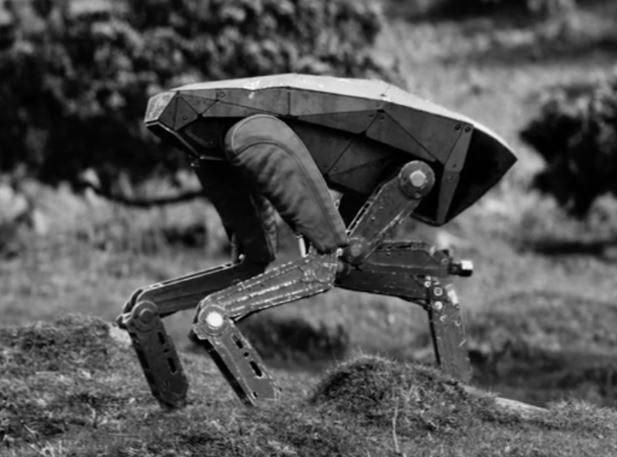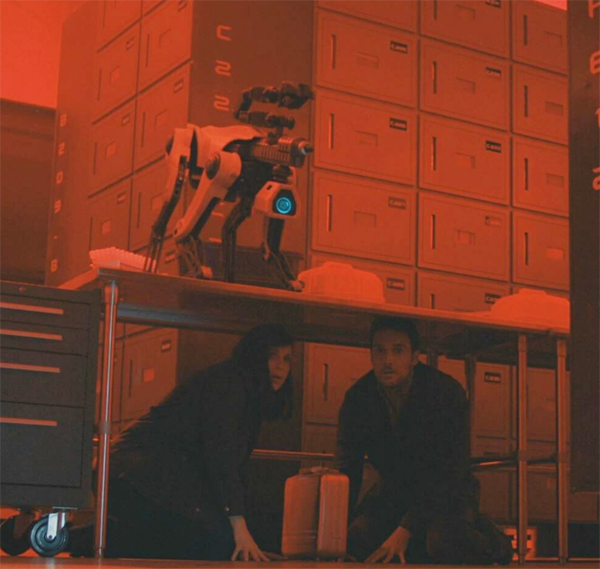
A World of Other DMZs Await
Dogfight on the DMZ?
Hyundai scoops up Boston Dynamics for $1.1B. Would Kim Jun-un counter with mega-dogs? Endless possibilities are afoot
The dogs of war?
So, when will we witness hundreds of armed and sensor-laden robot dogs scampering along Korea’s DMZ keeping watch on North Korea, or, for that matter, any of the other hundreds of DMZs around the world? Maybe Nagorno Karabak, maybe along the Rio Grande, maybe at voting sites at a future U.S. presidential election. So many opportunities, so few robot dogs. Think, Metalhead from Black Mirror.

Bloomberg reports that Boston Dynamics sold about 400 of its Spot robot dogs (on sale for about six months) “bringing in at least $30 million in revenue,” which is about $75k per mechanical canine. Probably too little to appease Softbank (its owner since 2017) which reportedly lays out approximately $150 million annually for Boston Dynamics, which recently moved into a larger, more expensive building and now has upwards of 300 staff. Ka-ching, ka-ching. Softbank, however, bought the company for $165 million from Google in 2017, and now has sold it to Hyundai Motor Group for $1.1 billion, a brief three years later. That’s a nice profit margin. Google bought Boston Dynamics for an undisclosed sum in 2013; it was one of eight robotics companies Google scooped up over a period of six months for Googler Andy Rubin to honcho, but Rubin left Google in 2014, after which disenchantment quickly set in with all things robotics at Google (now Alphabet)
Founded by former-CEO Marc Raibert in 1992, Boston Dynamics has a reputation as a protected paradise for R&D engineers living off DARPA and DoD contracts. Even at the height of the Great Recession (2008-2011), the company lived well. The work of the isolated, quiet company has always been nonpareil; the YouTube videos of its fantastic animal- and human-like machines (most going viral) have more viewings than all other robot videos combined. Such a successful culture totally fixated on producing eerily lifelike, amazing robotics can be many times a difficult atmosphere in which to breed a sense of commercialism.
Late last year, the company changed its CEO: Raibert out, and in as CEO came Rob Playter, “a former collegiate gymnast who wrote his PhD thesis on techniques for teaching robots to do somersaults” (think, Atlas). In an October interview, he said SoftBank was looking for profits. “While they want us to be a disciplined and commercial company, the actual direction of the company they are leaving to us.”
That, of course, was mistake number one. And truth be told, some R&D shops producing uncanny tech maybe should be left alone to do their thing, something like Lockheed’s Skunk Works.
“Now, they’re one company among many—ANYbotics and Unitree are just two examples of other quadrupeds that are being successfully commercialized.”
A country and new owner agog with robots
Now Boston Dynamics finds itself sucked into the Hyundai chaebol, which, regardless of its official partitions and ticker symbols, is still a singular, many-tentacled powerhouse of Korean industry, made purposefully—and successfully—opaque to thwart prying eyes.
It’s a union that may prove beneficial to Boston Dynamics, both as a skunk works and as a commercial success. Unlike its previous owners, Hyundai (Softbank still retains a 20 percent interest) has a world of robotics opportunities and unlimited resources ready to assist.
Plus, Korea is putting on a power move in robotics, which will offer more than fertile ground enough for Boston Dynamics to thrive.
With an eye towards becoming the world’s fourth-largest industrial robot player by 2023, according to the Korea Times, Korea is moving decisively to power up its robotics industry. It’s also setting goals to foster 20 mainline robotics companies, and to more than double industrial robot production from 300,000 to 700,000, and also to expand market size from the current $4.9 billion to $12.9 billion.
“Korea accounts for about 10 percent of the total supply, which makes it fifth in the world,” said Moon Jae-In, president of Korea Institute for Robot Industry Advancement (KIRIA).
Korea’s Third Robot Basic Plan will foster both the industrial and service robot sectors, as well as establish an improved ecosystem for local robotics companies.
In 2018, Korea rolled out Intelligent Robot Industry Development Acceleration Strategy. Back then, the Ministry of Trade, Industry and Energy (MOTIE) ponied up $467 million through 2020 to fund the Joint Robot Industry Development Initiative, which covers lots of domestic robot issues, but specifically tabs robots as “one of the new export industries”.
Back to the Future
Just in Time, Korea Leans on Technology for Help
The Robot Act of 2008 gets revamped, redirected and refinanced.
Korea’s New Robot Plan
The new five-year, Third Robot Basic Plan, according to Korea Times, will see: “The government supporting localization of key robot parts and software, demonstrating robot technology at the customers’ end, and a combination of 5G, AI and robots. To this end, the government said it will develop three core parts, such as an intelligent controller, and four software programs, such as smart gripping.
“With the advent of emerging technologies such as artificial intelligence (AI), internet of things (IoT) and fifth-generation (5G) network, the robot industry has become a key subject of the Fourth Industrial Revolution,” Moon told The Korea Times.
“Robots will play a pump-priming role to spur the economic development of Korea, helping local companies improve competitiveness and solve social problems such as labor shortage and care for elderly people.”
The Great Hyundai Robot Plan
Best known as a car manufacturer, Hyundai Heavy Industries also operates in multiple businesses from shipbuilding to finance…and robotics. Actually, it’s been involved in the robotics industry since 1984 (producing its first welding robot in 1987). As of May 2020, Hyundai Heavy Industries officially spun off the automation business into a new company, Hyundai Robotics.
A new entity seems odd at this late date, especially seeing that Korea has been the global leader in the density of robots to workers for years now. What took so long? Competition is already ferocious. “According to Hyundai Robotics, the reason for the spinoff is to facilitate expansion from manufacturing and commercial cleaning robots, to smart factory automation, including IIoT and robotics as service offerings.” Again, what took so long?
Korea’s Third Robot Basic Plan is part of the reason. LG, Samsung, and Hyundai will be major players in the Plan. Hyundai Robotics is also launching a subsidiary company, “Hyundai L&S, to develop logistics automation for the distribution market. The new entity plans to diversify its robotics offerings to include small, high-speed part handling robots, cobots and specialized mobile service robots for the electronics industry.”
To that point, it’s both as an automaker and a robot maker that Hyundai heads off to Jakarta (Indonesia) to build a new auto plant and to supply it with 370 of Hyundai’s own industrial robot brand. All in the family, Hyundai style, so to speak.
According to Hyundai Robotics, the order was won in competition with robotics firms from Germany, Switzerland and Japan. Did they ever have a real chance? After all, the Third Robot Basic Plan will need all the help it can get from its fellow countrymen in order to reach its lofty goals.
The $1.6 billion plant at the Deltamas Industrial Complex near Jakarta is slated to assemble 150,000 vehicles and grow to 250,000; Hyundai estimates that annual production for the region could reach over 4.5 million units by 2026. With those production numbers, more Hyundai-brand robots will be need before too long.
Hyundai is also “building an innovation center in Singapore where Hyundai will work on developing artificial intelligence, big data and other technologies to enhance its manufacturing processes, fine tuning the ‘brains’ behind the smarter and more environmentally friendly cars of tomorrow.”
“The deal comes as Hyundai gears up for investments in robotics and urban air mobility, seeking to make half of its revenue from the two new businesses. Hyundai Chairman Chung Euisun last year detailed his vision for a mobility solutions company, saying half of its sales would be automotive while 30 percent would come from urban air mobility and robotics would account for 20 percent.”
Apart from Hyundai Heavy Industry’s Robotics Division, Hyundai Motor Group also has its own. The Robotics Lab of Hyundai has demoed a line of exoskeletons like H-MEX, the Hyundai Medical EXoskeleton, and the “medical” version is designed to help paraplegic patients walk again, while other variants are designed for heavy lifting. And it’s here where Boston Dynamics will dwell.
“According to Ars Technica: “Boston Dynamics is working on adding more capabilities to its robot dog, though, namely in the form of an attachable arm coming early next year, which will allow the robot to manipulate objects and perform tasks. The company also sells the “Pick” vision system for robotic arms, and it’s working on moving further into the warehouse with the development of a depalletizing mechanical ostrich robot called “Handle.” Also currently in development is the very impressive humanoid robot, Atlas (it can do a backflip!) though Boston Dynamics says Atlas is “a research platform.”
The collision between Boston Dynamics and Hyundai will be interesting for robotics. Hopefully it will become a relationship that lasts longer than those with Google and Softbank.
In a country and with a company completely agog with robots as well as the future of robotics, Boston Dynamics should feel right at home with Korea and Hyundai. And yes, even for those who stay up late at night thinking up new gymnastic moves for Atlas. It was, after all, the Koreans who beat out everyone to win the 2015 DARPA Grand Challenge for humanoid robots.

The big question is North Korea’s response to a potential army of robot dogs in the DMZ. A reported TV buff, Kim Jun-un has probably seen Metalhead from Black Mirror and the guard-dog robots from Emergence. Might we eventually see mega-dogs, the size of Great Danes, romping along the barbed wire and baring their titanium teeth at Spot?

